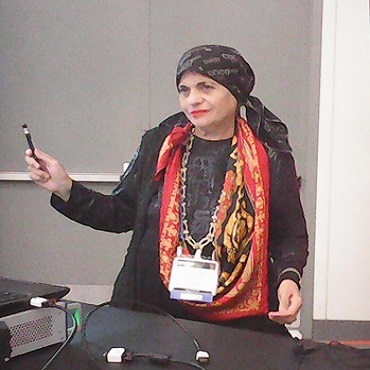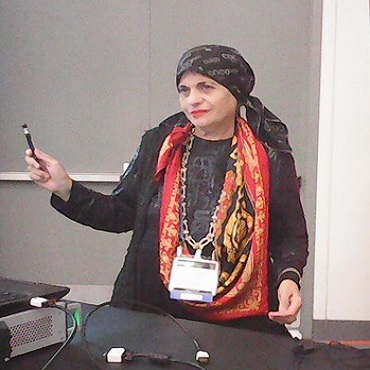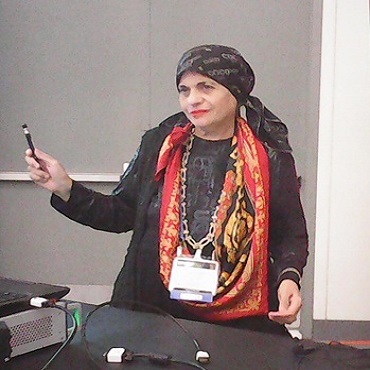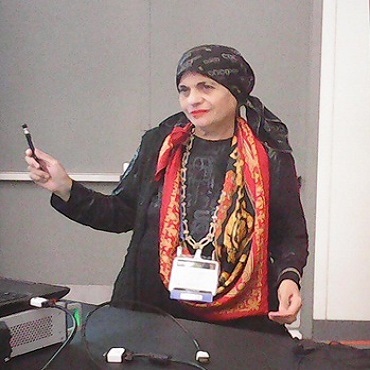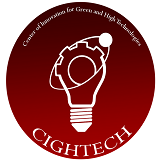
Nanoscience 2019
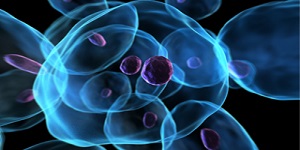
Theme: Interminable Explorations on Future Era of Nanoscience and Nanotechnology
Nanoscience 2019 gives a profound impulse into the most recent discoveries and innovative headways in the field of Nanoscience and Nanotechnology. It is a privilege to invite you on the upcoming “10th World Summit on Nanotechnology and Nanoscience” which will be scheduled during October 21-22, 2019 in Osaka, Japan. The program is a rich unification of formats running from keynote sessions highlighting some outstanding and thought provoking speakers to very intelligent talks which are proposed in a way where analysts and specialized staff from both scholarly world and industry can communicate making a stage for exchanging of knowledge, ideas and thoughts. Nanoscience 2019 gathers renowned scientists, Nanotechnologists, Nanoscience researchers, Scholars, Members of different Nanotechnology & related associations, Industry Professionals in the field of Nanoscience and Nanotechnology under a single roof where networking and global partnering happens for the acceleration of future research.
Session on: Nanomaterials
Nanomaterials are chemical substances or materials that are manufactured and used at a very small scale ranging between 1 and 100 (nm). Materials with structure at the nanoscale often have unique optical, electronic, or mechanical properties. Nano Materials are developed to exhibit novel characteristics compared to the same material without nanoscale features, such as increased strength, chemical reactivity or conductivity.
Keywords: Nanoscience Conference | Nanoscience Congress | Nanotechnology Conference | Nanoscience Meeting | Nanotechnolohy Event | Nanoscience Conference
Session on: Nanoelectronics
Nanoelectronics hold a few responses for how we may build the capacities of gadgets while we lessen their weight and control utilization. Enhancing show screens on gadgets. This includes lessening power utilization while diminishing the weight and thickness of the screens. Specialists are adding to a kind of memory chip with an anticipated thickness of one terabyte of memory for each square crawl or more prominent. Lessening the measure of transistors utilized as a part of coordinated circuits.
Keywords: Nanoscience Conference | Nanoscience Congress | Nanotechnology Conference | Nanoscience Meeting | Nanotechnolohy Event | Nanoscience Conference
Session on: Nanophysics
Any dense issue frameworks whose somewhere around one (out of three) measurement is of the request of nanometer can be considered as nanoscale framework. Nanoscience and nanotechnology are tied in with relating and abusing wonders for materials having one, a few measurements diminished to the nanoscale.
Keywords: Nanoscience Conference | Nanoscience Congress | Nanotechnology Conference | Nanoscience Meeting | Nanotechnolohy Event | Nanoscience Conference
Session on: Nanoengineering
Nanoengineering is the practice of engineering structures at the nanoscale level. It is an interdisciplinary science that builds biochemical structures at the nanoscale, smaller than bacterium. This is done by utilizing basic biochemical processes at the atomic or molecular level.
Keywords: Nanoscience Conference | Nanoscience Congress | Nanotechnology Conference | Nanoscience Meeting | Nanotechnolohy Event | Nanoscience Conference
Session on: Nanomedicine
Nanomedicine is the designing or manufacturing of biological devices, drugs and other biological components at the scale of molecular nano size to monitor, repair, construction, and control of human biological system. Nanomedicine is the medical application of nanotechnology including wide range of applications of biosensors, tissue engineering, diagnostic devices, and many others.
Keywords: Nanoscience Conference | Nanoscience Congress | Nanotechnology Conference | Nanoscience Meeting | Nanotechnolohy Event | Nanoscience Conference
Session on: Nanobiotechnology
Nanobiotechnology is an emerging field which is a combined stream of biotechnology and nanotechnology. It is a discipline in which tools from nanotechnology are developed and applied to study biological phenomena. For example, nanoparticles conserve as probes, sensors or vehicles for biomolecule delivery in cellular system, peptoid, nanosheets, cantilever array sensors and the application of nanophotonic for manipulating molecular processes in living cells.
Keywords: Nanoscience Conference | Nanoscience Congress | Nanotechnology Conference | Nanoscience Meeting | Nanotechnolohy Event | Nanoscience Conference
Session on: Nanotoxicology
Nanotoxicology is the branch of toxicology that deals with the study of the toxicity of nanomaterials.Nanotoxicological studies are intended to determine whether and to what extent these properties may pose a threat to the environment and to human beings. Example: diesel soot, manufacturing and naturally occurring process.
Keywords: Nanoscience Conference | Nanoscience Congress | Nanotechnology Conference | Nanoscience Meeting | Nanotechnolohy Event | Nanoscience Conference
Session on: Nanorobotics
Nanorobotics are engineered robots or small machines designed at nanometre scale (10-9metres). It is an advanced technology and these nanorobots are constructed with the molecular components ranging from 0.1 to 10 micrometers. In other terms it can be also be described as nanomite, nanite, nanoid, nanobot, and nanomachine.
Keywords: Nanoscience Conference | Nanoscience Congress | Nanotechnology Conference | Nanoscience Meeting | Nanotechnolohy Event | Nanoscience Conference
Session on: Nanochemistry
Nanochemistry is a new branch of chemistry associated with the combination of chemistry and nanoscience. It involves the synthesis of building blocks or assemblies of atoms or molecules at (1-100 nm). Also, it involves the study of characterization of molecules of nanoscale size and being used in chemical, materials and physical, science as well as engineering, biological and medical applications.
Keywords: Nanoscience Conference | Nanoscience Congress | Nanotechnology Conference | Nanoscience Meeting | Nanotechnolohy Event | Nanoscience Conference
Session on: Green Nanotechnology
Green Nanotechnology can be defined as how the nanotechnology can enhance the environmental sustainability and benefit the environment. It includes making green nano-products, using less energy during the manufacturing process, eco-friendly materials, the ability to recycle products after use and using nano-products in support of sustainability.
Keywords: Nanoscience Conference | Nanoscience Congress | Nanotechnology Conference | Nanoscience Meeting | Nanotechnolohy Event | Nanoscience Conference
Session on: Nanofluidics
Nanofluidics is the investigation of the conduct, manipulation, and control of liquids that are kept to structures of nanometer (ordinarily 1– 100 nm) trademark measurements (1 nm = 10−9 m). Liquids restricted in these structures show physical practices not saw in bigger structures, for example, those of micrometer measurements or more, on the grounds that the trademark physical scaling lengths of the liquid, (e.g. Debye length, hydrodynamic sweep) nearly correspond with the measurements of the nanostructure itself.
Keywords: Nanoscience Conference | Nanoscience Congress | Nanotechnology Conference | Nanoscience Meeting | Nanotechnolohy Event | Nanoscience Conference
Session on: Molecular Nanotechnology
Molecular Nanotechnology (MNT) is defined as one of the most advanced forms of Nanotechnology which is used for manufacturing the mechanical or functional machines at molecular scale or miniature level by means of mechano synthesis guided by molecular machine systems. MNT would involve the physical demonstration of the existing principles of chemistry and biophysics and other nanotechnologies.
Keywords: Nanoscience Conference | Nanoscience Congress | Nanotechnology Conference | Nanoscience Meeting | Nanotechnolohy Event | Nanoscience Conference
Session on: Polymer Nanoscience
Polymer Nanoscience is the study and application of nanoscience to polymer-nanoparticle matrices called Polymer nanocomposites (PNC) consist of a polymer or copolymer having nanoparticles or nanofillers dispersed in the polymer matrix. This varies with different shapes (e.g., platelets, fibres, spheroids), but at least one dimension must be in the range of 1–50 nm. It requires controlled mixing/compounding and stabilization of the dispersion phase.
Keywords: Nanoscience Conference | Nanoscience Congress | Nanotechnology Conference |Nanoscience Meeting | Nanotechnolohy Event | Nanoscience Conference
Session on: Nanophotonics
Nanophotonics or nano-optics is the investigation of the conduct of light on the nanometer scale, and of the cooperation of nanometer-scale objects with light. It is a part of optics, optical building, electrical designing, and nanotechnology. It frequently (however not solely) includes metallic parts, which can transport and concentrate light through surface plasmon polaritons.
Keywords: Nanoscience Conference | Nanoscience Congress | Nanotechnology Conference | Nanoscience Meeting | Nanotechnolohy Event | Nanoscience Conference
Nanotechnology has been the greatest impetus to technological and industrial development in the 21st century and guarantees to impact several sectors such as of nanomaterials, Nanotools, and Nano devices of the world economy, as proved by double-digit growth rates. And has been recognized as the resource for the next industrial revolution. The nanotechnology-based products are now entering the consumer market that had a huge effect on industrial sector.
By 2024, the global Nanotechnology market is expected to exceed US$ 125 Billion mark.
Nanomaterials have the highest share in the global nanotechnology market. This includes well developed industrial nanotechnology applications such as nanoparticle-based nanolithographic tools, nanoscale electronic memory, sunblock products and nanocatalyst thin films and nano-thin film solar cells. Nanodevices segment captured least share of the global nanotechnology market. The nanotools accounted for second highest share of the nanotechnology market. Nanolithography tools dominate the global nanotools component market.
Biomedical, consumer and electronics applications ought to demonstrate the highest projected CAGR rates (i.e., 29.9%, 27.9%, and 20.5%, respectively) throughout the forecast period.
The National Nanotechnology Initiative (NNI) receives quite $1.4 billion from the 2017 Federal Budget, for affirming the necessary role that nanotechnology continues to play within the Administration’s innovation agenda.
Scope and Importance:-
Nanotechnology and Medicine is a broad, diverse and multidisciplinary field. It is continuous interaction with basic disciplines and is also contributing to meet all Grand Societal Challenges. This contribution is such that numerous reports have been produced in recent years in Asia and world - wide, with the aim of drawing a comprehensive picture and proposing coordinated actions towards the establishment of coherent strategies in the field. The present report subscribes to this perspective, with a particular goal which is to contribute to the establishment of a comprehensive view of the role in efficient development of key enabling technologies.
Market Value on Nanotechnology and Medicine Research:-
Nanotechnology involves the study of phenomena and manipulation of matter on a nanometre scale and development of a wide range of tools, objects, structures, devices, systems and techniques of nanotechnologies. This is a fast-growing area of research and development. It is widely predicted that the nanotechnologies will become a central focus for driving economic growth in the 21st century. These fields are attracting rapidly increasing investments from governments and from businesses across the globe. The aim of the current UK Strategy for nanotechnologies is to describe the actions necessary to ensure that the UK obtains maximum economic, environmental and societal benefit from nanotechnologies while keeping the risks properly managed (EPSRC).
Nanotechnology has the ability to solve problems associated to human civilizations, pertaining to both basic needs and aspirations for a comfortable life. Although nanotechnology involves the manipulation of matter on an atomic, molecular and supramolecular scale, the specific technological goal is of precisely manipulating atoms and molecules for fabrication of macro scale products, also now referred to as molecular nanotechnology. Nanotechnology is evolving towards becoming a general-purpose technology by 2020, encircling four generations of products with increasing structural and dynamic complexity such as Passive nanostructures, active nanostructures, nano systems, molecular Nano systems.
Recent research study, "Nanotechnology Market Outlook 2017", RNCOS' analysts have identified that the global nanotechnology industry has been growing at a rapid pace with rising applications in sectors like electronic, energy, healthcare sector etc. In addition, market trends like nanotechnology-based thin film solar cells with high efficiency; nanomaterials with higher strength; robust growth in nanofibers and nanomedicine market; etc., are booming growth in this industry. Considering the above factors, the global nanotechnology market is anticipated to grow at a CAGR of around 19% during 2013-2017.
|
Product |
Global market |
Compound annual growth rate |
Year |
|
|
Million |
Year |
|||
|
Quantum dots |
$610.0 |
2016 |
41.30% |
2016-2021 |
|
Nanofibers |
$276.0 |
2014 |
38.60% |
2015-2021 |
|
Carbon nanotubes |
$158.6 |
2014 |
33.40% |
2014-2019 |
|
Nanofilteration membrane |
$215.5 |
2014 |
15.60% |
2014-2019 |
|
Nanocomposites |
$225.0 |
2014 |
21.10% |
2014-2019 |
The U.S. consumed more than $3.1 billion worth of advanced and nanoscale ceramic powders in 2010. Consumption is projected to increase to nearly $3.4 billion in 2011 and $5.4 billion in 2016, a projected compound annual growth rate (CAGR) of 9.9% between 2011 and 2016. Molecular Diagnostics market is likely to grow at healthy CAGR between 2016 and 2021.
Nanotechnology has been the greatest incentive to technological and industrial development in the 21st century and has been recognized as the resource for the next industrial revolution. The evolving technology has already influenced a significant impact of industrial segments, and the economic activity generated from it has been high in magnitude and wide in scope. The nanotechnology-based products, which have had an enormous impact on almost each industrial sector, are now entering the consumer market in a big way.
In this report, the analysts have studied the nanotechnology market by application, by component and by region. On the application front, they have analysed nanotechnology use in electronics, energy, cosmetics, medical and defence sector. In addition, they have covered the current nanotechnology market and forecast for each of the above-mentioned segments till 2018. In terms of component, the nanotechnology market can be segregated into nanomaterials, nanotools and nanodevices. The report covers their present and future shares in the market.
Further, country level analysis discusses nanotechnology market in major countries like USA, Germany, France, the U.K., Russia, etc., the present key growth drivers, and future directions for each nation. In addition, it covers the nanotechnology patent analyses, including number of patent publications and global top assignees of nanotechnology patent literature.
Besides this, the report covers the global R&D funding for the nanotechnology industry, including break-ups for corporate, public and venture capital funding along with their forecasts. The report even covers country-level analysis of R&D funding to provide in-depth understanding about investment related to nanotechnology.
The nanotechnology global market report
The nanotechnology market reports consist of two large areas: commercial and research community.
The number of schools and colleges that offer attractive programs in nanotechnology is increasing; we are providing the list of the most successful nanotechnology engineering schools in the world based on their dedication to research, education, facilities, and industrial cooperation.
Best Nanotechnology Universities in the world
- Nanyang Technological University, Singapore
- Massachusetts Institute of Technology, United States
- Georgia Institute of Technology, United States
- Stanford University, United States
- University of California, United States
- Tsinghua University, China
- Peking University, China
- National University of Singapore, Singapore
Nanotechnology Societies in USA
- International Institute for Nanotechnology (IIN)
- American Nano Society
- International Association of Nanotechnology (IANT)
- IEEE Nanotechnology Council
- Institute for Molecular Manufacturing (IMM)
- Microscopy Society of America (MSA)
- Nano Science and Technology Institute (NSTI)
- NanoBusiness Commercialization Association
- American Chemistry Council Nanotechnology Panel
- International Council on Nanotechnology (ICON)
Nanotechnology Societies in Europe
- European Society for Precision Engineering and Nanotechnology (EUSPEN)
- British Society for Nanomedicine
- Nanotechnology Industries Association (NIA)
- Royal Microscopical Society
- Royal Society-Nanotechnology and Nanoscience
- Schau-Platz NANO
- Safenano
- Innovationsallianz Carbon Nanotubes (Inno.CNT)
- Czech Nanotechnology Industries Association
- European Society for Molecular Imaging (ESMI)
-
Erwin Schrödinger Society for Nanosciences
-
National Institute for Nanotechnology
Nanotechnology Societies in Asia and Middle East
-
Nano Technology Research Association
-
Russian Society of Scanning Probe Microscopy and Nanotechnologies
-
Nano Science and Technology Consortium (NSTC)
-
Centre for Nano and Soft Matter Sciences
-
National Centre for Nano-Structured Materials, CSIR
-
Institute of Nano Science and Technology
-
Iran Nanotechnology Initiative Council (INIC)
-
Sri Lanka Institute of Nanotechnology
-
National Nanotechnology Center (NanoTec)
-
National Center for Nanoscience and Technology
Total nanotechnology companies
The markets for nanotechnology products and nanotechnology uses are set to grow in the coming years. Nanotechnology uses include everything from more efficient drug delivery systems to tiny transistors that allow for smaller and more powerful computer chips.
Major nanotechnology companies in USA
- MEMS Optical
- Bourne Research
- SDCmaterials
- Focal Point Microsystems
- Materials and Electrochemical Research Corporation
- NanoMech
- Nanomaterials and Nanofabrication Laboratories (NN-Labs)
- DuPont Air Products Nanomaterials
- QuantumSphere
- Nanomix
- NeoPhotonics
- Quantum Dot Corporation
- Nanoscale Combinatorial Synthesis Inc.
- Nanogen
- Nanotrope
- Nanotherapeutics
Major nanotechnology companies in Asia
- Beijing Nano Sunshine Technology Co. Ltd, China
- Advanced Battery Technologies, China
- Nano-Infinity Nanotech Co., Taiwan
- Asia Pacific Fuel Cell Technologies, Taiwan
- Qtech Nanosystems, India
- Velbionanotech, India
- Fullerene International Corporation (FIC), Japan
- Hitachi High-Technologies, Japan
- Advanced Nano Technologies, Korea
- Nanogist, Korea
- Arc Flash Corporation, Malaysia
- Institute of Bioengineering and Nanotechnology (IBN), Singapore
Keywords: Nanoscience Conference | Nanoscience Congress | Nanotechnology Conference
- Nanomaterials
- Nanoelectronics
- Nanophysics
- Nanoengineering
- Nanomedicine
- Nanobiotechnology
- Nanotoxicology
- Nano Robotics
- Nanochemistry
- Green Nanotechnology
- Nanofluidics
- Molecular Nanotechnology
- Polymer Nanoscience
- Nanophotonics
- Journal of Nanomaterials & Molecular Nanotechnology




